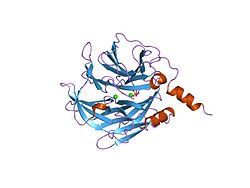Paraoxonase 1 (PON1) also known as Serum paraoxonase and arylesterase 1, A esterase, homocysteine thiolactonase or serum aryldialkylphosphatase 1, is an enzyme that in humans is encoded by the PON1 gene.[5] Paraoxonase 1 has esterase and more specifically paraoxonase activity.[6] PON1 is the first discovered member of a multigene family also containing PON2 and PON3, the genes for which are located adjacent to each other on chromosome 7. PON1 on HDL (different from soluble PON1) is responsible for significant atheroprotection rendered by the HDL.[7]
- ^ a b c GRCh38: Ensembl release 89: ENSG00000005421 – Ensembl, May 2017
- ^ a b c GRCm38: Ensembl release 89: ENSMUSG00000002588 – Ensembl, May 2017
- ^ "Human PubMed Reference:". National Center for Biotechnology Information, U.S. National Library of Medicine.
- ^ "Mouse PubMed Reference:". National Center for Biotechnology Information, U.S. National Library of Medicine.
- ^ Primo-Parmo SL, Sorenson RC, Teiber J, La Du BN (May 1996). "The human serum paraoxonase/arylesterase gene (PON1) is one member of a multigene family". Genomics. 33 (3): 498–507. doi:10.1006/geno.1996.0225. PMID 8661009.
- ^ van Himbergen TM, van Tits LJ, Roest M, Stalenhoef AF (Feb 2006). "The story of PON1: how an organophosphate-hydrolysing enzyme is becoming a player in cardiovascular medicine". The Netherlands Journal of Medicine. 64 (2): 34–8. PMID 16517986.
- ^ Kumar S, Maniya N, Wang C, Satyajyoti S, Chang HC (Feb 2023). "Quantifying PON1 on HDL with nanoparticle-gated electrokinetic membrane sensor for accurate cardiovascular risk assessment". Nature Communications. 14 (557): 557. Bibcode:2023NatCo..14..557K. doi:10.1038/s41467-023-36258-w. PMC 9895453. PMID 36732521.






